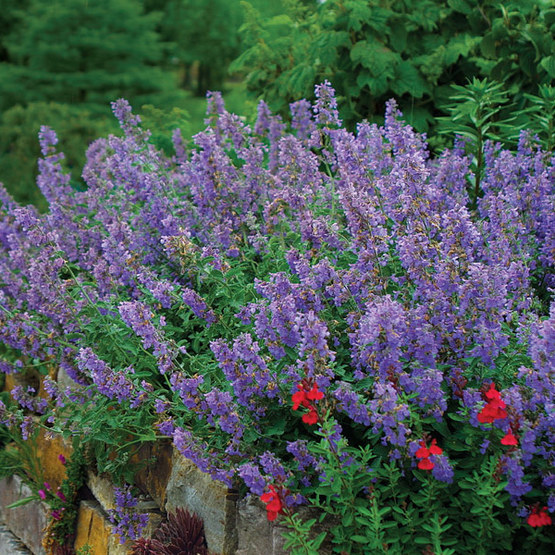
The term “ground cover” often conjures up visions of boring patches of plain green foliage—adequate for simply filling space but hardly satisfying for the color-craving gardener. Fortunately, numerous spreading perennials do an equally good job protecting the soil and crowding out weeds while producing a bounty of beautiful blooms. Mass plantings of these easy-care perennials are great for new gardens because just a few can fill plenty of space, easing the strain on your budget. In established landscapes, linking individual shrubs into larger beds with flowering ground covers dramatically cuts down on tedious mowing and trimming chores.
The best ground covers for smaller spaces are those that have a long season of bloom but typically need light trimming or deadheading after the first flush to keep the flowers coming. Keeping these plants in manageable patches simplifies this modicum of maintenance because you can reach all of the plants from outside the bed. To fill a large space, you need a ground cover that will do much of the work for you. Fortunately, you have several good options: substantial clumpers that stretch widely in all directions, ground-hugging creepers with stems that readily take root where they rest on the soil, or spreaders that produce new plants from wide-ranging roots. All 10 flowering ground covers that I recommend earn top marks for their long bloom season, resistance to pests and diseases, and ability to fill quickly an area of any size.
Repeat bloomers are best for small spaces
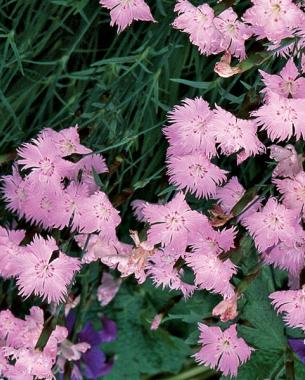
The fringed flowers of ‘Bath’s Pink’ pink (Dianthus ‘Bath’s Pink’ ) make the plant look delicate, but its tenacious nature earns it a top spot in the category of flowering ground covers. Older pinks have a reputation for “melting out” during sultry summer weather, but ‘Bath’s Pink’ is more tolerant of heat and humidity. It also adapts to a wide range of soil conditions but prefers a neutral to slightly alkaline pH. Good drainage, though, is a must, especially in winter. Late spring to early summer is the peak season for its fragrant flowers, but scattered blooms can appear later, too, especially if you shear off the faded flower heads. When the plants aren’t in bloom, the dense carpets of slender, blue-green leaves provide ample interest through the rest of the growing season and into winter.
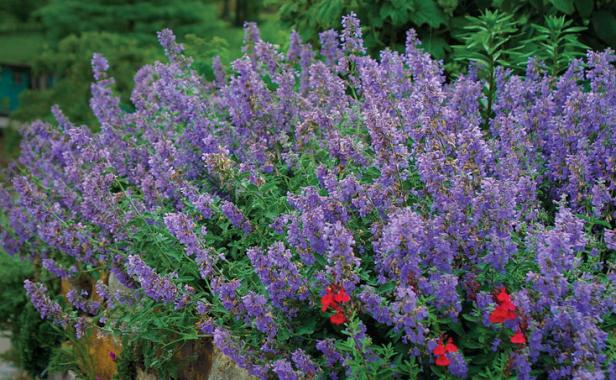
While I’m currently a fan of bright-colored flowers like those on ‘Bath’s Pink’, I can’t resist the soft blues and grays of catmint (Nepeta spp. and cvs.). My favorite is ‘Walker’s Low’ (Nepeta × faassenii ‘Walker’s Low’ ). Its compact habit makes it a particularly pleasing ground cover around hydrangeas and other flowering shrubs. The 15- to 20-inch-tall mounds of gray-green foliage are attractive all through the growing season and emit a minty aroma when you brush against them. From late spring to midsummer, they’re topped with 6- to 8-inch-long spikes of purple-blue flowers; a light midsummer shearing encourages rebloom in late summer and fall. Once established, ‘Walker’s Low’ is extremely drought tolerant.
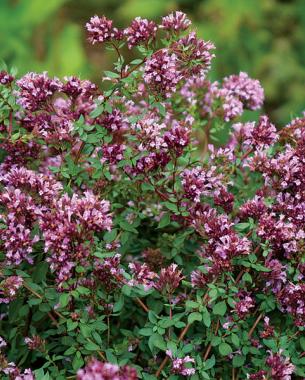
Oreganos (Origanum spp. and cvs.) are another excellent ground cover for those who enjoy fragrance and flowers. While the spicy-scented leaves of ‘Herrenhausen’ oregano (O. laevigatum ‘Herrenhausen’) lack the rich flavor of culinary selections, their showy clusters of purplish pink flowers and deep purple bracts add flavor to the landscape. The plants grow in somewhat sprawling, 1- to 2-foot-tall mounds, with small leaves that emerge purplish in spring, turn rich green in summer, and age to deep reddish purple in autumn. The 1- to 2-inch-wide bloom clusters appear in midsummer and keep coming into fall (especially with deadheading); they are favorites with butterflies and make terrific cut flowers, too. An extremely low-maintenance plant, ‘Herrenhausen’ tolerates heat and drought once established.
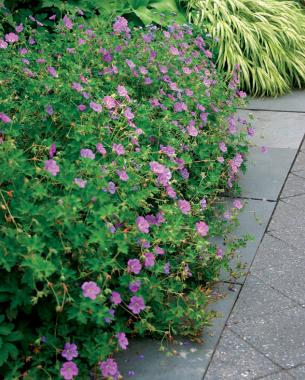
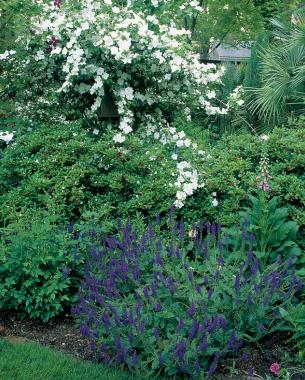
As with oreganos, a great number of geraniums make superb ground covers. Among these excellent options, ‘Rozanne’ (Geranium ‘Rozanne’ ) stands out for its abundance of blooms over an amazingly long season. Starting in early summer, the spreading mounds of deeply cut, lightly mottled green leaves are covered with 2½-inch-wide, saucer-shaped blooms. In cool conditions or some shade, the flowers tend to be clear blue with a prominent white center; in hot weather or strong sun, they often appear more lavender blue with a tiny white eye. Shearing lightly in midsummer helps to tidy the plants and can promote rebloom well into autumn. This selection can be a little slower to sprout in spring than other geraniums, so interplant ‘Rozanne’ with spring crocus, species tulips, and other small bulbs if you want earlier color.
Because most ground covers tend to form mats or low mounds, ‘Goodness Grows’ veronica (Veronica ‘Goodness Grows’) offers a welcome touch of verticality with its slender, distinctly spiky blooms. The narrow bright green foliage forms a mat that rarely exceeds 6 inches in height. But the deep blue racemes double the plant’s height from late spring to midsummer. A single shearing or regular deadheading encourages reblooming into fall. Of all the veronicas, ‘Goodness Grows’ is the best ground cover because it’s one of the lowest-growing, longest-blooming, and most reliable cultivars.
Big clumpers and fast spreaders work in large areas
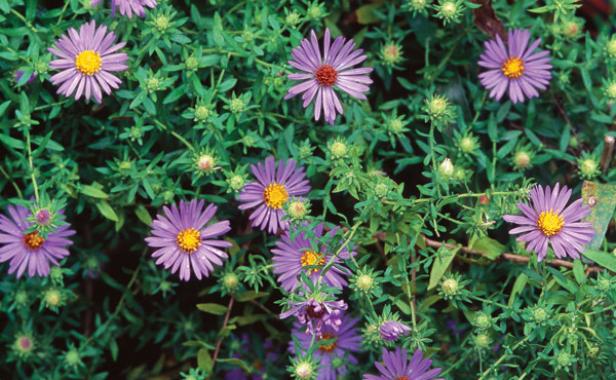
Asters (Aster spp. and cvs.) are something out of the ordinary as a flowering ground cover. While most of these clump-forming perennials tend to grow up rather than out, cultivars of Aster oblongifolius, such as ‘October Skies’, can occupy quite a bit of space, even in their first year. This aromatic aster may not flower until early to midfall, but it’s worth waiting for. Through most of the season, the dense, 2-foot-tall mounds of slender green leaves look like tiny trimmed shrubs. In autumn, they finally burst into bloom, smothered with hundreds of fragrant, daisylike lavender blue flowers. ‘October Skies’ continues to bloom through the first few frosts and holds its form well through the winter, providing exceptional late-season interest. The individual plants stay in distinct clumps, but their tops spread out quite a bit, filling a space about 2 feet across.
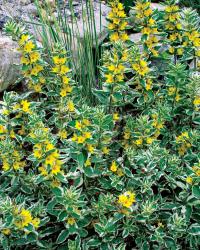
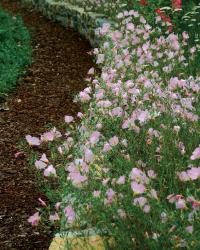

Combine bright blooms with variegated foliage, and you’ve got a ground cover that is always eye-catching. Yellow loosestrife (Lysimachia punctata) is known for its 1-inch-wide sunny yellow flowers that cover the top half of the upright stems from midsummer to fall; ‘Alexander’ has the added feature of a white edge around each leaf. Tough and dependable, this 2-foot-tall spreader can grow just about anywhere, from sun to shade and moist to dry soil; just be aware that the combination of strong sun and very dry soil can cause the leaf tips to turn brown. This species is not as aggressive as its cousin, gooseneck loosestrife (Lysimachia clethroides), nor is it related to the invasive purple loosestrife (Lythrum salicaria).
Another fast spreader is Mexican evening primrose (Oenothera berlandieri). Don’t let this deceptively dainty-looking perennial loose in your regular garden beds, but if you have a space where its fast-creeping roots can spread freely without invading other plants (or your lawn), it makes a top-notch ground cover. It bears small dark green leaves that may be tinged with red, and it typically grows 6 to 12 inches tall. The cupped, 2- to 3-inch-wide blooms range from bright pink to white. Flowers can appear from spring well into fall, sometimes taking a break during the hottest part of the summer.
If you want a more restrained pink-flowered plant, try ‘John Creech’ sedum (Sedum spurium ‘John Creech’). Evergreen in mild climates, it spreads gently to produce dense, 2-inch-tall carpets of lightly scalloped leaves. The ¼- to ½-inch-wide bright pink flowers are held in tight clusters just above the foliage. ‘John Creech’ typically blooms in mid- to late summer, although gardeners have reported it flowering in late spring and early fall. Full sun with dry soil is best for ample bloom, but the plants can adapt to dry shade, too; moist soil leads to looser growth less likely to keep out weeds.


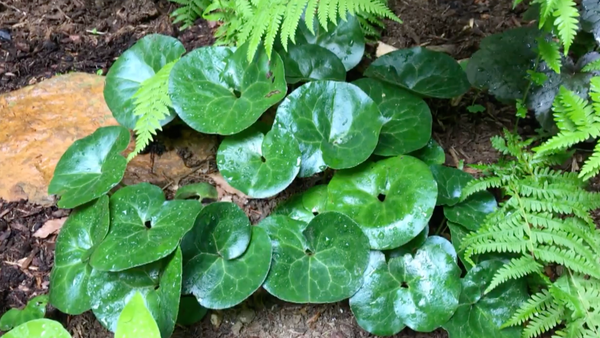
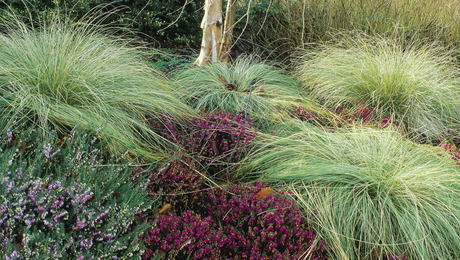

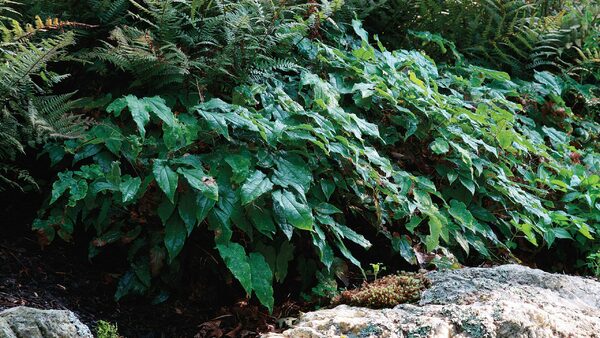
















Comments
What about the native: creeping phlox (Phlox subulata)? Features: low growth habit, flowering, and (sometimes) evergreen.
woo-hoo! i love me some phlox!!
Mexican primrose is another garden thug. The fine-filament network of root systems do a wonderful job of breaking up soil density, but also have very deep roots that drive elsewhere, bringing new shoots to spring up anywhere - anywhere. I liked the pollinator-supportive element about this plant, so I left it when a seed mix brought it on board. There is no getting rid of them without deep digging, and that is a problem when it springs up in the midst of other perennial plant groupings. So far, it has invaded Iris (Siberian and Bearded), penstemon, the lawn, space between flagstones. Apparently seeds blew some distance over to a wildflower section of the yard and are now aggressively in pursuit of the space there. If I'd known, I'd've planted it alone in a concrete-encircled enclosure.
Georgia veronica (Veronica umbrosa 'Georgia Blue') is probably my favorite groundcover. Cheery blue flowers early in spring and often again in late summer/autumn. Good at keeping down weeds but letting perennials grow through and easily divisible without being thuggish. Can walk on it without doing much damage. Not fussy about soil nor requires more than part sun.
Log in or create an account to post a comment.
Sign up Log in